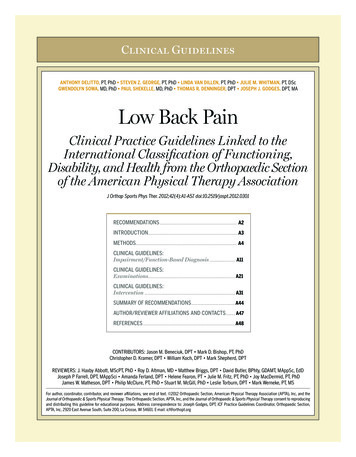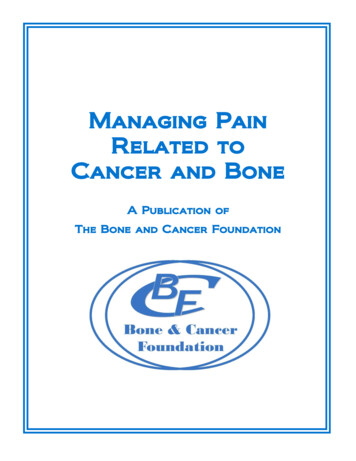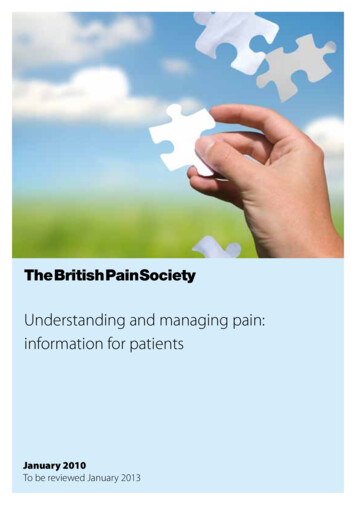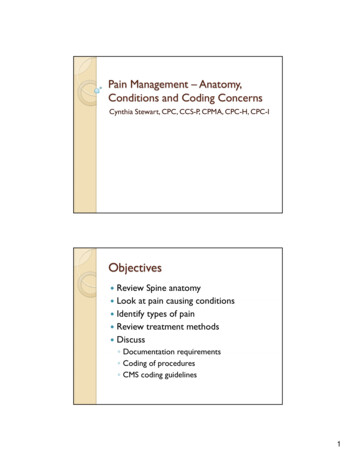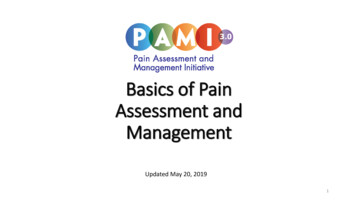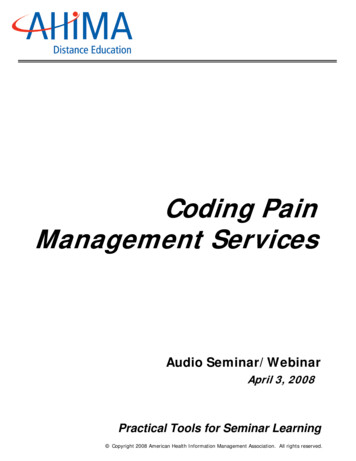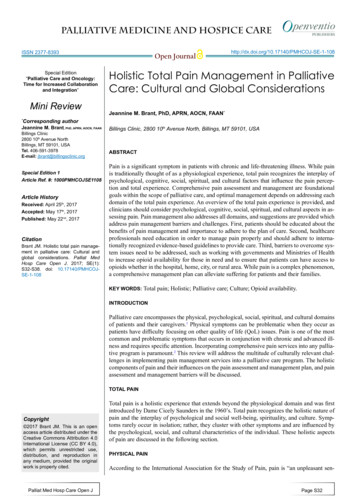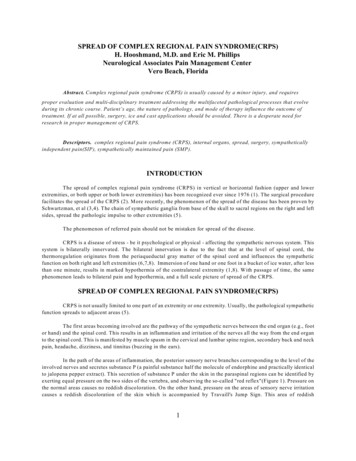
Transcription
SPREAD OF COMPLEX REGIONAL PAIN SYNDROME(CRPS)H. Hooshmand, M.D. and Eric M. PhillipsNeurological Associates Pain Management CenterVero Beach, FloridaAbstract. Complex regional pain syndrome (CRPS) is usually caused by a minor injury, and requiresproper evaluation and multi-disciplinary treatment addressing the multifaceted pathological processes that evolveduring its chronic course. Patient’s age, the nature of pathology, and mode of therapy influence the outcome oftreatment. If at all possible, surgery, ice and cast applications should be avoided. There is a desperate need forresearch in proper management of CRPS.Descriptors. complex regional pain syndrome (CRPS), internal organs, spread, surgery, sympatheticallyindependent pain(SIP), sympathetically maintained pain (SMP).INTRODUCTIONThe spread of complex regional pain syndrome (CRPS) in vertical or horizontal fashion (upper and lowerextremities, or both upper or both lower extremities) has been recognized ever since 1976 (1). The surgical procedurefacilitates the spread of the CRPS (2). More recently, the phenomenon of the spread of the disease has been proven bySchwartzman, et al (3,4). The chain of sympathetic ganglia from base of the skull to sacral regions on the right and leftsides, spread the pathologic impulse to other extremities (5).The phenomenon of referred pain should not be mistaken for spread of the disease.CRPS is a disease of stress - be it psychological or physical - affecting the sympathetic nervous system. Thissystem is bilaterally innervated. T he bilateral innervation is due to the fact that at the level of spinal cord, thethermoregulation originates from the periaqueductal gray matter of the spinal cord and influences the sympatheticfunction on both right and left extremities (6,7,8). Immersion of one hand or one foot in a bucket of ice water, after lessthan one minute, results in marked hypothermia of the contralateral extremity (1,8). W ith passage of time, the samephenomenon leads to bilateral pain and hypothermia, and a full scale picture of spread of the CRPS.SPREAD OF COMPLEX REGIONAL PAIN SYNDROME(CRPS)CRPS is not usually limited to one part of an extremity or one extremity. Usually, the pathological sympatheticfunction spreads to adjacent areas (5).The first areas becoming involved are the pathway of the sympathetic nerves between the end organ (e.g., footor hand) and the spinal cord. This results in an inflammation and irritation of the nerves all the way from the end organto the spinal cord. This is manifested by muscle spasm in the cervical and lumbar spine region, secondary back and neckpain, headache, dizziness, and tinnitus (buzzing in the ears).In the path of the areas of inflammation, the posterior sensory nerve branches corresponding to the level of theinvolved nerves and secretes substance P (a painful substance half the molecule of endorphine and practically identicalto jalopena pepper extract). This secretion of substance P under the skin in the paraspinal regions can be identified byexerting equal pressure on the two sides of the vertebra, and observing the so-called "red reflex"(Figure 1). Pressure onthe normal areas causes no reddish discoloration. O n the other hand, pressure on the areas of sensory nerve irritationcauses a reddish discoloration of the skin which is accompanied by Travaill's Jump Sign. This area of reddish1
discoloration can be easily blocked and dissipated by injection of local anesthetic such as Marcaine and if the conditionis chronic and severe, one can add a small amount of Celestone or Depo - Medrol to it. This nerve block providesexcellent relief of pain and reversal of constriction of the blood vessels.Figure 1. Cervical neuropathic pain represented with hypothermia on ITI in the paravertebral area.Gentle pressure exerted over the cervical spine (Left) revealed reactive release of inflammatorychemicals and blushing of the skin in the hypothermic area. Treatment with paravertebral nerveblocks (Right) provides pain relief, and dissemination of irritative substances P. Massage therapyafter paravertebral nerve blocks provide a longer lasting relief for the patient.Another area of involvement of CRPS is the spinal cord itself. This is manifested by movement disorder, musclespasm, weakness of the extremity, as well as urgency and frequency of urination and disturbance of erection.Invasive procedures such as the insertion of a spinal cord stimulator (SCS) can flare-up such an involvementof the spinal cord and it can cause "idiopathic paralysis" due to flare-up and constriction of blood vessels to the spinalcord. The same can be noted in rare cases of insertion of a catheter for sympathetic nerve blocks in the paravertebral orepidural regions.In the visceral involvement of CRPS the skin is usually cold and the deep structures are hot and have anexaggerated blood circulation. This results in osteoporosis, fracture of the bones, areas of swelling and fluid formationbetween the bones and joints identified on MRI, and severe pain as well as weakness in the deep structures. This causesa high risk of amputation for the patient. Amputation is totally unnecessary and should never be performed. Just simpleweight bearing under the effect of a strong analgesic such as Stadol or Buprenorphine (Buprenex) along with the use ofmoist, warm water and epsom salt, exercise and massage for the extremity to reverse the vasoconstriction on the surfaceand to increase the circulation in the deep structures corrects this situation without the need for amputation. Amputationin CRPS is a slow, painful, gradual suicide.The next structures being involved in some cases of CRPS are the blood vessels to the kidney with resultantepisodes of sudden brief and temporary bleeding through the kidney accompanied by a marked elevation of bloodpressure. The same principle can cause attacks of nose bleeds, severe headache, dizziness, passing out spells as well.Application of Clonodine Patch in the area of the kidney in the flank (in the back) usually results in good relief of suchspasm and inflammation of the blood vessels. The patient should be treated with Dibenzyline or Hytrin which are lifesaving in such patients.2
The involvement of other sympathetic midline connections and plexi such as celiac (abdominal pain, pepticulcer, nausea, vomiting, and weight loss), superior and inferior mesenteric plexi (diarrhea, abdominal cramps, and weightloss), and cardiac plexus (chest pain, abnormal heart beat, tachycardia, and heart attack), and carotid and vertebral plexi(severe vascular headaches, dizziness, tinnitus, attacks of falling spells, and syncopal attacks), should be identified assuch and should be treated with the help of Clonodine Patch, Hytrin, or Dibenzyline as well as proper treatment appliedto the source of CRPS (definitely avoiding ice, but encouraging exercise, moist heat, warm water and epsom salt, andnewer antidepressants are the best analgesics of choice for CRPS).The involvement of the same midline plexi explains the reason for the involvement of other organs symmetricalon the opposite side such as the opposite hand or opposite foot or opposite side of the head in regard to headache andface pain or involvement of the removed areas such as involvement of right hand because of left knee injury)(Figure 2).Figure 2. Vertical and midline connections and plexi of sympathetic nervous system.This complex intermingling of SNS fibers renders unilateral sympathectomyineffective in the long run. The affinity of the sympathetic nervous system to the spineexplains the involvement of the SNS in spinal injuries in the form of “neuropatheticpain.” “SMP” and in other manifestations such as vascular headaches, vertebral arteryinsufficiency (dizziness, tinnitus, ataxia, and poor memory, and, extremity or visceralinflammation.3
Because of the above complex phenomenon and because of the fact that in CRPS the sympathetic nerves followthe path of the blood vessels rather than somatic nerve roots resulting thermotomal rather than dermatomal sensory nervedistribution (mistaken for hysterical sensory loss) may cause a complex clinical picture that baffles the clinician andforces the clinician to blame the patient as being hysterical, hypochondriac, and blaming the serious warning signs ofCRPS as "functional and not organic". The end result is the deadly phrase "it is all in your head" which practically almostall CRPS patients have had to put up with in the course of their treatment. Then the patient is sent to the psychiatrist whotries to shut the patient up with strong tranquilizers, benzodiazepams, Haldol, Valium, Xanax, Halcion, Ativan, Tranxene,etc., with further disastrous results by aggravating CRPS due to inactivity, and due to the stress of strong addictingbenzodiazipams affecting the formation of brain's own endobenzodiazepams and endorphines.The sympathetic system is complex, bilateral, and diffuse. Its job is alerting the mechanism to alert the entirebody against stress and its manifestations are complex and multifaceted.FACTORS IN THE SPREAD OFCOMPLEX REGIONAL PAIN SYNDROME (CRPS)The usual factors facilitating the spread of the disease are surgical procedures, application of ice, and stress oftoo much activity or inactivity (6). In our study of 824 CRPS patients, the number one aggravator was cryosurgery,followed by surface cryotherapy applied more than two months. The surface cryotherapy less than two months did notshow the tendency for spread of CRPS (6,9)(Table 1).Cryosurgery, similar to radiofrequency surgery, does not limit the freezing damage to a circumscribed nerve.The concentric field of freezing cannot limit itself to a small anatomical target. Damage to the adjacent normal nervescontribute to spread and expansion of the lesion.Table I. The therapeutic influence of cryotherapy and cryosurgery on the out come of the disease (Stages I-IV).Characteristics oftreatment(% of 284 patients)Stage I *number of patientsStage IInumber of patientsStage III-IV**number of patientsCryotherapyRx 2 M onths236Patients16 (7% )92 (39% )128 (54% )(P 0.001)CryotherapyRx 2 M onths34 Patients13 (38% )11 (32% )10 (30% )Cryosurgery14 Patients0 (0% )1 (7.15 % )13 (92.85% )(P 0.001)(*) Stage I Dysfunction; Stage II Dystrophy; Stage III Atrophy; Stage IV Autonomic and Immune System Failure.(**) Depending on the nature of treatment, stage III may reverse to stage I and vice-versa.STAGES OF CRPSCRPS has been divided into four different stages. Depending on the nature of injury, the stages vary in theirduration. In the 22 patients suffering from venipuncture CRPS in our series, deterioration from stage I to stage III wasmeasured in a few weeks up to less than 9 months (10). This is in contrast with CRPS in children in whom stages wouldstagnate, reverse or improve slowly.4
Stage I , is a sympathetic dysfunction with typical thermatomal distribution of the pain . The pain may spreadin a mirror fashion to contralateral extremity or to adjacent regions on the same side of the body(11). In stage I, the painis usually sympathetically maintained pain (SMP) in nature (Table II).In stage II, the dysfunction changes to dystrophy manifested by edema, hyperhidrosis, neurovascular instabilitywith fluctuation of livedo reticularis and cyanosis - causing change of temperature and color of the skin in matter ofminutes. The dystrophic changes also include bouts of hair loss, ridging, dystrophic, brittle and discolored nails, skinrash, subcutaneous bleeding, neurodermatitis, and ulcerative lesions (Figures 3,4,5). Due to the confusing clinicalmanifestations, the patient may be accused of factitious self-mutilation and "Münchausen syndrome(12)." All thesedystrophic changes may not be present at the same time nor in the same patient(13). Careful history taking is importantin this regard.In stage III, the pain is usually no longer SM P and is more likely a sympathetically independent pain(SIP).Atrophy in different degrees is seen. Frequently, the atrophy is overshadowed by subcutaneous edema. The complexregional pain and inflammation spread to other extremities in approximately one-third of CRPS patients (13-15). At stageII or III it is not at all uncommon for CRPS to spread to other extremities(1,2,11,16). At times, it may becomegeneralized (11). The generalized CRPS is an infrequent late stage complication. It is accompanied by sympatheticdysfunction in all four extremities as well as attacks of headache, vertigo, poor memory, and poor concentration. Thespread through paravertebral and midline sympathetic nerves may be vertical, horizontal, or both(1,11,17,18). Theoriginal source of CRPS may sensitize the patient to later develop CRPS in another remote part of the body triggeredby a trivial injury. The ubiquitous phenomenon of referred pain to remote areas (e.g., from foot or hand to spine) shouldnot be mistaken for the spread of CRPS.At stage III, inflammation becomes more problematic and release of neuropeptides from c-fiber terminals resultsin multiple inflammatory and immune dysfunctions. The secondary release of substance P may damage mast cells anddestroy muscle cells and fibroblasts(19-22).STAGE IV:(i). Failure of the immune system, reduction of helper T-cell lymphocytes and elevation of killer T-celllymphocytes.(ii). Intractable hypertension changes to orthostatic hypotension.(iii). Intractable generalized edema involving the abdomen, pelvis, lungs, and extremities.(iv). Ulcerative skin lesions which may respond to treatment with I.V. Mannitol, I.V. Immunoglobulin, andACTH treatments.Calcium channel blockers such as Nifedipine may be effective in treatment (23).(v). High risks of cancer and suicide are increased.(vi). Multiple surgical procedures seem to be precipitating factors for development of stage IV.Stage IV is almost the flip side of earlier stages, and points to exhaustion of autonomic and immune systems.Ganglion blocks in this stage are useless and treatment should be aimed at improving the edema and the failing immunesystem. Sympathetic ganglion blocks, alpha blockers, including Clonidine, are contraindicated in stage IV due tohypotension. Instead, medications such as Proamantin (midodrin) are helpful to correct the orthostatic hypotension(6,24).5
Figure 4. 9/27/96: Lesions became ulcerated(10).Figure 3. 9/22/96: Venipuncture CRPS II, five months after ablood test, resulted in neuroinflammatory bulbous lesions(10).Figure 5. 11/1/96: The lesion healed after treatment with I.V. mannitol and I.V. immunoglobulin treatment(10).6
Table II. W ith passage of time, and types of treatment, CRPS goes through stages with variable time tables andsympathetic responses.StagesSigns / SymptomsStage I: DysfunctionHyperpathia; Allodynia; Muscle W eakness; FlexorSpasms; Thermal ChangesStage II: DystrophyEdema; Skin; Hair and Nail ChangesStage III: AtrophyMuscle Atrophy; Neurovascular Instability; CutaneousRash or Skin UlcersStage IV: Irreversible Disturbance of Plasticity;Systemic Autonomic Failure; Visceral Edema;Irreversible Low BP; MRSA; Elephantiasis; CancerAutonomic FailureSTAGING CAN BE MISLEADINGDogmatic reliance on staging is somewhat artificial in nature. Each patient follows a different course. In childrenand teenagers, the prognosis is excellent and stages need not develop with passage of time due to the fact that their richcerebral growth hormone, sex hormone and endorphin formation prevent deterioration(25-29). The same logic appliesto pregnant women. W ith early treatment, the disease is frozen at stage one. Even patients suffering from stages II or IIIrevert to stage I with proper treatments. The reverse is true: unnecessary surgery, as an stressor can cause rapid regressionfrom stage I to III, as well as spreading the disease to other extremities (6).SURGERYElective surgery for presumptive conditions such as carpal tunnel, tarsal tunnel, and thoracic outletsyndrome (TOS)- in spite of normal nerve conduction studies - only adds a new source of neuropathic pain at thesurgical scar. According to Cherington, et al , there is a tendency for unnecessary TOS surgery, elective surgery isthe strongest predictor (P 0.001) of poor treatment outcome(30).According to Rowbotham, "amputation is not to be recommend as pain therapy(31)." All 11 patients in ourseries of 824 CRPS patients who underwent amputation showed marked deterioration post-op. The surgical stumpwas the source of multiple neuromas with sever CRPS II type of intractable pain. Amputation should be avoided byall means due to its side effects of aggravation of pain and tendency for spread of CRPS (6).Twenty-two of 824 CRPS patients, had undergone surgical sympathectomy with temporary partial relief of 6days to 38 weeks in 9 patients: up to 54 weeks in 10 patients: and no relief in 3(6). Chemical sympathectomy was done(prior to referral to our medical center) on 13 patients with temporary relief of 3 days to 29 weeks in 4 patients, no reliefin 5, and rapid deterioration of CRPS in 4 patients (6). Surgical, radiofrequency and chemical or (neurolytic),sympathectomies, have been applied in treatment of CRPS since 1916(32,33). Sympathectomy may provide temporarypain relief, but after a few weeks to months it loses its effect(5,34). The success has been limited to the series that havehad short-term patient follow-ups of a few months after surgery. Sympathectomy and application of neurolytic agentsshould be limited to patients with life expectancies measured in weeks or months - e.g., cancer and end stage advancedocclusive vascular disease patients(5). On the other hand, CRPS patients usually have 3 to 5 decades of life expectancyahead of them(5). They should not be exposed to aggravation of pain due to sympathectomy. The sympathectomizedpatients developed post operative spread of CRPS in 12 of our 35 patients (37%). This high incidence of spread is incontrast to the 18% incidence in the rest of 824 cases(6).7
Surgical procedures in neuropathic pain patients, in general, are sources of stress and produce characteristicneuro-endocrine and metabolic responses, local inflammation, and can cause disturbance of immune system function.The body responds in the opposite direction to surgery for somatic versus neuropathic pain. An acuteappendicitis or cholecystitis responds quite nicely to surgery. On the other hand, surgery in the area of the extremityinvolved with neuropathic pain has the potential of aggravating the condition. Tissue damage from the surgicalprocedures results in the local release of inflammatory neurokines. This biochemical and cellular chain of events leadsto up-regulation of the immune system and nervous system activation by releasing Substance P, histamine, serotonin,CGRP, bradykinin, prostaglandins, and other agents. This leads to a local vasodilation response in the area of the surgicalscar, increased capillary permeability, and sensitization of the peripheral afferent nerve fibers resulting in allodynia andhyperpathia. Surgery can cause suppression of immune function aggravating the manifestations of neuropathic pain. Postoperatively, there is a tendency for dysfunction of the lymphocytic role in immune regulation. This is manifested by adecrease in number of T-cell lymphocytes and the function of the T-cell lymphocytes. The disturbance and suppressionof the immune system due to surgery enhances the malignant tumor growth and metastasis . Surgery "results in aperturbation of nervous, endocrine and immune system as well as their interregulatory mechanisms leading tocompromised immunity." This disturbance of immunity may manifest itself in skin ulcerations noted in 2 of 11 amputeesreferred to our clinic during a five year period from 1990-1995. A similar case of an amputee with skin ulcers has beenrecently reported .INTERNAL ORGAN INVOLVEMENTCRPS invariably involves the internal organs. Usually the skin surface is cold at the expense of increasedcirculation to the internal organs. This increased circulation can cause osteoporosis, fractures of bone, abdominal crampsand diarrhea, disturbance of absorption of foods with resultant weight loss, water retention with aggravation ofpremenstrual headaches and depression, persistent nausea and vomiting, as well as severe vascular headaches mistakenfor "cluster headache".In addition, CRPS can cause the complication of intractable hypertension which responds best to alpha Iblockers (Dibenzyline, Hytrin, or Clonodine). CRPS can cause attacks of irregular or fast heart beat, chest pain, coronaryartery spasm (angina), as well as disturbance of function of other internal organs. A few examples are frequency andurgency of urination, respiratory disturbance such as dyspnea and apneic attacks, and attacks of severe abdominal pain.Laparoscopy may reveal congestion and inflammation of the ovaries, uterus or small bowel.Attacks of fluctuating blood pressure may also be accompanied by constriction of the blood vessels to thekidney resulting in periodic bleeding in the urine as well.The internal organs complication may become aggravated by traumatic effect of sympathetic nerve blocks. Onesuch complication is accidental trauma to the kidney with resultant hematuria (blood in urine) and aggravation of hypertension.The use of nerve blocks and more importantly physical therapy can help improve the skin circulation and reducethe deep circulation calming down the inflammatory affect of CRPS over the internal organs. As mentioned above, alphaI blockers are quite affective in treatment of this condition.Attacks of swelling of the internal organs complicated by intermittent constriction of the blood vessels todifferent organs can result in chest pain, attacks of sharp central pain (stabbing severe pain in the chest or abdomen), andchanges in voice (suddenly developing a temporary "chipmunk" type of voice change). The sharp, stabbing, central paincan be helped with treatment with medications such as anticonvulsants (Tegretol or Neurontin).8
The use of catheters adjacent to the sympathetic chain such as in the lumbar sympathetic chain can help preventrepeated needle infection from sympathetic nerve blocks. However, because of the congestion of the internal organs thecatheter may irritate the sympathetic nerve branches causing constriction of the blood vessels to the spinal cord withtemporary paraplegia. As soon as the weakness of extremities develops, the catheter should be removed. Not heedingto this ominous sign can result in paralysis of the lower extremities and incontinence.CONCLUSIONThe main reason for CRPS becoming bilateral and spreading to other extremities is because in contrast to thesomatic nervous system, the sympathetic nervous system has bilateral innervation. In the somatic nervous system (usualsensation and motor function) the abnormalities in dermatome in a specific nerve root distribution, whereas in CRPS theabnormality is distributed among the blood vessels, distribution of nerves (thermatomes) and to the sympathetic gangliaand their across the midline collections, the condition reflects itself on both sides rather than one side of the body. Thisbilateral manifestation through the sympathetic plexi across the midline explains the patient's problem with headache,dizziness, tinnitus, chest pain, and abdominal manifestations of CRPS (gastritis, diarrhea, cramps) and spread of CRPSto other extremities.In treating CRPS, even if the opposite extremity looks normal, the treatment should be given to both extremitiesbecause of this principle of bilateral innervation.9
References1. Kozin F, McCarty DJ, Sims J, Genant H. The reflex sympathetic dystrophy syndrome. I. Clinical and histologicstudies: evidence of bilaterality, response to corticosteroids and articular involvement. Am J Med 1976; 60:321-331.2. Radt P. Bilateral reflex neurovascular dystrophy following a neurosurgical procedure. Clinical picture andtherapeutic problems of the syndrome. Confinia. Neurl 1968; 30 (5): 341-348.3. Schwartzman RJ. Reflex sympathetic dystrophy. Handbook of Clinical Neurology. Spinal Cord Trauma,H.L.Frankel, editor. Elsevier Science Publisher B.V. 1992; 17: 121-136.4. Maleki J, LeBel AA, B ennett GJ, Schwartzman RJ. Patterns of Spread of complex regional pain syndrome, type I(reflex sympathetic dystrophy). Pain 2000; 88: 259-266.5. Hooshmand H. Chronic pain: reflex sympathetic dystrophy. Prevention and management. Boca Raton, FL: CRCPress, 1993; pp 1-202.6. Hooshmand H, and Hashmi H. Complex regional pain syndrome (CRPS, RSDS) diagnosis and therapy. A reviewof 824 patients. Pain Digest 1999; 9: 1-24.7. Appenzeller, O. The Autonomic Nervous System: An introduction to basic and clinical concepts. 4th rev., Elsevier1990; 148.8. Gibbon JH, Landis EM. Vasodilation in the lower extremities in response to immersing the forearms in warm water.J Clin Invest 1982; 2: 1019-1036.9. Hooshmand, H., Hashmi, M., Phillips, E.M.: Cryotherapy can cause permanent nerve damage: A case report.AJPM 2004; 14: 2 : 63-70.10. Hooshmand H, Hashmi M, Phillips EM. Venipuncture complex regional pain syndrome. AJPM 2001; 11: 112-124.11. Veldman PH, Goris RJ: Multiple reflex sympathetic dystrophy which patients are at risk for developing arecurrence of reflex sympathetic dystrophy in the same or another limb. Pain 1996; 64:463-466.12. Lipp KE, Smith JB, Brandt TP, et al: Reflex sympathetic dystrophy with mutilating ulcerations suspiciousof a factitial origin. J Am Acad Dermatol 1996; 35:843-845.13. Chelimsky T, Low PA, Naessens JM, et al: Value of autonomic testing in reflex sympathetic dystrophy.Mayo Clinic Proceedings 1995; 70:1029-1040.14. Fredriksen TA, Hovdal H, Sjaastad O: “Cervicogenic headache”: clinical manifestation. Cephalalgia1987;7:147-160.15. Moskowitz MA: The neurobiology of vascular head pain Ann Neurol 1984; 16:157-168.16. Schwartzman RJ, McLellan TL: Reflex sympathetic dystrophy. A review. Arch Neurol 1987; 44:555-561.17. Duncan KH, Lewis RC, Racz G, et al: Treatment of upper extremity reflex sympathetic dystrophy withjoint stiffness using sympathetic bier blocks and manipulation. Orthopedics 1988;11:883-886.18. Cayla J, Rondier J: [Reflex algodystrophy of the legs of vertebro-pelvic origin (apropos of 23case)]Algodystrophies reflexes des membres inferieurs d'origine vertebroipelvienne (a propos de 23 cas). Sem Hop1974; 50:275-286.10
19. Ardid D, Guilbaud G: Antinociceptive effects of acute and ‘chronic’ injections of tricyclic antidepressant drugsin a new model of mononeuropathy in rats. Pain 1992; 49: 279-287.20. Payan DG, Brewster EJ, Goetzl EJ: Stereospecific receptor for substance P on cultured human IM-9lymphoblasts. J Immol 1984; 133:3260-3265.21. Payan DG: Receptor-mediated mitogenic effects of substance P on cultured smooth muscle cells. BiochemBiophysiol Res Commun 1985; 130: 104-109.22. Payan DG, McGillis JP, Goetzl EJ: Neuroimmunology. Advances in Immunology 1986; 39:299-323.23. W ebster GF, Iozzo RV, Schwartzman RJ, et al: Reflex sympathetic dystrophy: occurrence of chronic edemaand non- immune bulbous skin lesions. Archives Am Acad Dermatol 1993;28:29-32.24. Low P A, Gilden JL, Freeman R, et al: Efficacy of midodrine vs placebo in neurogenic orthostatic hypotension.A randomized double- blind multicenter study. JAMA 1997;277:1046-1051.25. Bernstein BH, Singsen BH, Kent JT, et al: Reflex neurovascular dystrophy in childhood. J Pediatr 1978;93:211-215.26. W ilder RT, Berde CB, W olohan M, et al: Reflex sympathetic dystrophy in children. J Bone Joint and Surg1992; 74:910- 919.27. Lemahieu RA, Van Laere C, Verbruggen LA: Reflex sympathetic dystrophy: an under reported syndromein children? European J Pediat 1988:147:47-50.28. Olsson GL, Arner S, Hirsch G: Reflex sympathetic dystrophy in children. In advances in pain researchtherapy, edited by D.C. Tyler and E.J. Krane. New York Raven Press. 1990; 15: 323-331.29. Pillemer FG, Micheli LJ: Psychological considerations in youth sports. Clin Sports Med 1988;7:679-689.30. Cherington M, Happer I, Machanic B, et al: Surgery for thoracic outlet syndrome may be hazardous to yourhealth. Muscle Nerve 1986; 9: 632-634.31. Rowbotham MC: Complex regional pain syndrome type I (reflex sympathetic dystrophy). More than a myth.Editorial. Neurology 1998; 51: 4-5.32. Leriche R.: De la causalgie, envisagee comme une nevrite du sympathique et de son traitement Par la denudationet l’excision des plexus nerveus periarteriels. Presse Med 1916; 24:178-180.33. Blum SL, Lubenow T: Neurolytic Agents. Current Review of Pain 1996; 1:70-78.34. Ochoa JL, Verdugo RJ: Reflex sympathetic dystrophy: A common clinical avenue for somatoform expression.Neurol Clin 1995;13:351-363.11
12
excellent relief of pain and reversal of constriction of the blood vessels. Figure 1. Cervical neuropathic pain represented with hypothermia on ITI in the paravertebral area. Gentle pressure exerted over the cervical spine (Left) revealed reactive release of inflammatory chemicals and blushing of the skin in the hypothermic area.



